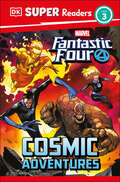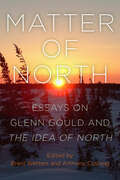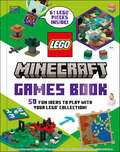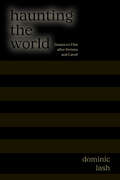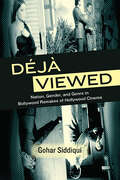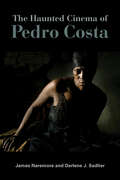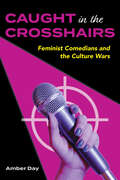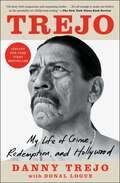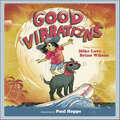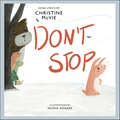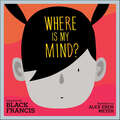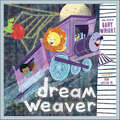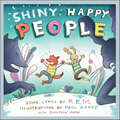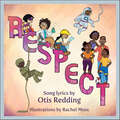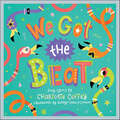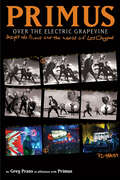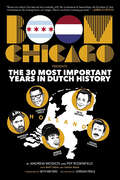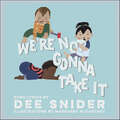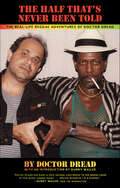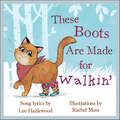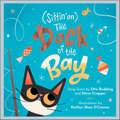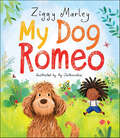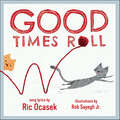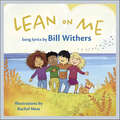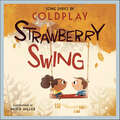- Table View
- List View
DK Super Readers Level 3 Marvel Fantastic Four Cosmic Adventures (DK Super Readers)
by DKBoost your reading skills with the Fantastic Four on their adventures across the Multiverse in this fun-filled Level 3 reader, carefully leveled to help children progress in their reading ability.Discover some of the Fantastic Four’s greatest adventures and most dangerous foes as they protect the planet from threats from all over the Multiverse!Packed with fun facts, exciting color images, simple vocabulary and a fun quiz, this Level 3 reader will engage young Marvel Super Hero fans and help them build confidence in reading.The DK Super Readers series can help your child practice reading by:Covering engaging, motivating, curriculum-aligned topics.Building knowledge while progressing Grades 3 and 4 reading skills.Developing subject vocabulary on popular topics, including Super Heroes and other pop culture icons.Boosting understanding and retention through comprehension quizzes.Each title, which has been leveled using MetaMetrics®: The Lexile Framework for Reading, integrates science, geography, history, nature, and popular fiction topics, so there’s something for all children’s interests.DK Super Readers Level 3 titles are visually engaging, full of fun facts about exciting topics, and motivate children to improve their non-fiction reading skills. They are perfect for children ages 8 to 10 (Grades 3 and 4) who are newly independent readers ready to advance.© 2025 MARVEL
Matter of North: Essays on Glenn Gould and The Idea of North
by Brent Wetters Anthony CushingDocuments and illuminates Glenn Gould's groundbreaking radio composition, The Idea of North.Matter of North collects essays and source material related to Glenn Gould's landmark 1967 radio documentary The Idea of North. The most famous product (other than his studio piano recordings) of Gould's 1964 decision to abandon the concert stage for the recording studio, it combines Gould's interests in the contrapuntal (by the simultaneous layering of speaking voices) with philosophy and a life-long fascination with the Canadian Arctic. Because the documentary is a multivalent work, the contributors approach the documentary from unique perspectives (sociological, philosophical, music-theoretical, ethnomusicological), each illuminating a salient aspect of the work. The source-material section includes for the first time the complete interview responses by Gould's five participants, along with other important documentation.
LEGO Minecraft Games Book: 50 Fun Ideas to Play with Your LEGO Collection!
by Julia MarchThis edition does not include LEGO elements.Keep the whole family entertained with 50 ideas for LEGO® Minecraft® themed games, puzzles, and challenges!Challenge friends to a Nether minecart race. Find the odd crafting block out. Design your own LEGO Minecraft fairground. And much more!Get ready to level up the fun with your friends and family:ALL-NEW GAME IDEAS: Explore 50 brand-new LEGO Minecraft models and ideas for games, challenges, and puzzles – perfect for playing with family, friends, or on your ownSOMETHING FOR EVERYONE: The activities and games are great for all ages, making this the perfect gift for young LEGO builders and avid Minecraft fans alikeBuild in some time for bite-sized family fun with the LEGO Minecraft Games Book, packed with hours’ worth of ideas for LEGO Minecraft games, puzzles, and challenges. Also included are 61 Minecraft themed LEGO elements to add to your own collection and use alongside the games in the book, making this the ultimate experience for fun-loving LEGO Minecraft enthusiasts.©2025 The LEGO Group.©2025 Mojang AB.
Haunting the World: Essays on Film After Perkins and Cavell (SUNY series, Horizons of Cinema)
by Dominic LashArgues that the experience of the ordinary film viewer and the investigations of the film scholar or film philosopher are not necessarily so far apart.In Haunting the World, Dominic Lash tries to show that taking films seriously in no way interferes with the pleasure we get from watching them. The book draws its title from the philosopher Stanley Cavell, who saw "haunting the world" as something we are all prone to and who claimed that cinema's relationship with this tendency is both an "importance" and a "danger" of film. Specifically, Lash proposes that the work of Cavell and of the critic and scholar V. F. Perkins have valuable lessons to offer contemporary film studies, some of which are in danger of being neglected. Written in a lively and approachable style that makes philosophical ideas accessible without simplifying them, the book argues that film theory risks going awry when it dismisses or underestimates the experience of the ordinary film viewer. Haunting the World offers fresh accounts of fundamental topics, including description, experience, and agency, and examines in detail important films by Ildikó Enyedi, Paul Thomas Anderson, Ridley Scott, Werner Herzog, Andrei Tarkovsky, Kelly Reichardt, and more.
Déjà Viewed: Nation, Gender, and Genre in Bollywood Remakes of Hollywood Cinema (SUNY series, Horizons of Cinema)
by Gohar SiddiquiSituates the remake as one of the primary responses to Bollywood's globalization and corporatization.Focused on post-1990 Bollywood remakes of Hollywood films, Déjà Viewed tells a larger story of the rapidly changing Indian film industry in the wake of globalization and corporatization. It situates the remake as a gendered response to these changes, drawing on approaches from film theory, gender studies, and cultural studies. The book looks at films from a variety of genres and modes, including the Bollywood family film, romantic comedy, noir, and melodrama, and each film's close analysis is accompanied by attention to concerns related to remake theory, such as homage, anxiety of influence, defamiliarization, and pastiche. Seeking to historicize how gender and genres become translated and transformed in the Bollywood remake, the book contributes to transnational understandings of gender and genre as media texts move across various borders—geographic, cinematic, economic, and aesthetic.
The Haunted Cinema of Pedro Costa
by James Naremore Darlene J. SadlierFor over three decades, Portuguese director Pedro Costa has been widely admired for his unusual and innovative body of work, which has earned accolades and wide acclaim. The Haunted Cinema of Pedro Costa is the most complete treatment of his work, exploring Costa's feature films from Blood to Vitalina Varela, and from the documentaries to the short films, museum exhibitions, and the forthcoming Daughters of Fire. Authors James Naremore and Darlene J. Sadlier situate Costa within the history and culture of Portugal, at the same time providing insightful close readings and stylistic analysis of the films. Their work explores the unusual features of his artistry and illuminates his unique contribution to cinema. An accessible portrait of an important artist, The Haunted Cinema of Pedro Costa is an indispensable companion for scholars, students, and cinephiles everywhere.
Caught in the Crosshairs: Feminist Comedians and the Culture Wars (Comedy & Culture)
by Amber DayThe landscape of comedy has undergone a seismic shift in recent years with an increasing number of female comedians breaking through to mainstream audiences. Women are claiming high-profile roles as late-night hosts, sketch comedians, television producers, and standup stars. As they disrupt industry norms and transgress cultural boundaries, they have also become lightning rods for controversy, eliciting flares of anger, amazement, revulsion, or hope.Caught in the Crosshairs delves not only into the work of feminist icons like Samantha Bee, Amy Schumer, Leslie Jones, Michelle Wolf, and Hannah Gadsby, but also into the discourse surrounding their comedy. Author Amber Day argues that these debates transcend mere entertainment; they are cultural battlegrounds for larger philosophical and political conflicts, interrogating ideals of gender, race, power, and public space. We see conflicts over what should be considered scandalous or beyond the pale, who should be in the intended audience, what is appropriate behavior for which performing bodies, and what the boundaries of comedy ultimately are. Caught in the Crosshairs is an examination of how feminist comedy reflects the tensions of our times, disrupting established narratives and challenging traditional power structures.
Trejo: My Life of Crime, Redemption, and Hollywood
by Danny Trejo Donal LogueINSTANT NEW YORK TIMES BESTSELLER &“If you&’re a fan like I am this is definitely the book for you.&” —Pete Davidson, actor, producer, and cast member on Saturday Night Live &“Danny&’s incredible life story shows that even though we may fall down at some point in our lives, it&’s what we do when we stand back up that really counts.&” —Robert Rodriguez, creator of Spy Kids, Desperado, and Machete Discover the full, fascinating, and inspirational true story of Danny Trejo&’s journey from crime, prison, addiction, and loss—it&’s &“enough to make you believe in the possibility of a Hollywood ending&” (The New York Times Book Review).On screen, Danny Trejo the actor is a baddie who has been killed at least a hundred times. He&’s been shot, stabbed, hanged, chopped up, squished by an elevator, and once, was even melted into a bloody goo. Off screen, he&’s a hero beloved by recovery communities and obsessed fans alike. But the real Danny Trejo is much more complicated than the legend. Raised in an abusive home, Danny struggled with heroin addiction and stints in some of the country&’s most notorious state prisons—including San Quentin and Folsom—from an early age, before starring in such modern classics as Heat, From Dusk till Dawn, and Machete. Now, in this funny, painful, and suspenseful memoir, Danny takes us through the incredible ups and downs of his life, including meeting one of the world&’s most notorious serial killers in prison and working with legends like Charles Bronson and Robert De Niro. An honest, unflinching, and &“inspirational study in the definition of character&” (Kevin Smith, director and actor), Trejo reveals how he managed the horrors of prison, rebuilt himself after finding sobriety and spirituality in solitary confinement, and draws inspiration from the adrenaline-fueled robbing heists of his past for the film roles that made him a household name. He also shares the painful contradictions in his personal life. Although he speaks everywhere from prison yards to NPR about his past to inspire countless others on their own road to recovery and redemption, he struggles to help his children with their personal battles with addiction, and to build relationships that last. Redemptive and painful, poignant and real, Trejo is a portrait of a magnificent life and an unforgettable and exceptional journey.
Good Vibrations (LyricPop)
by Brian Wilson Mike LoveMike Love and Brian Wilson’s world-famous song, gloriously illustrated by Paul Hoppe, will bring smiles to the faces of children and parents alike.“Zany fun . . . Good Vibrations is a good book for an aging Baby Boomer, a hipster, or a beach-going anyone.” —New York Journal of Books“I’m pickin’ up good vibrationsShe’s giving me the excitationsGood, good, good, good vibrationsShe’s giving me the excitations . . ."Good Vibrations is a lively picture book based on Mike Love and Brian Wilson’s number one hit about absorbing positive energy from the people around them. Often praised as one of the most important compositions in rock, the Beach Boys’ original version of this song was their third number one Billboard hit. With lyrics by Brian Wilson and Mike Love, and illustrations by Paul Hoppe, this picture book follows a girl and her dog as they make their way down to the beach, sharing good vibrations all along the way. Parents and children alike can share and enjoy one of rock’s greatest hits through the colorful pages of Good Vibrations.
Don't Stop (LyricPop)
by Christine McVieMcVie's classic song about keeping one's chin up and rolling with life's punches is beautifully adapted to an uplifting children's book.“Gorgeous . . . Christine McVie’s lyrics paired with woodland creatures in Don’t Stop is truly as wondrous as it sounds.” —Exclusive Magazine“Don’t stop thinking about tomorrowDon’t stop, it’ll soon be hereIt’ll be better than beforeYesterday’s gone, yesterday’s gone . . .”Don’t Stop is a beautifully illustrated picture book based on Christine McVie of Fleetwood Mac’s enduring anthem to optimism and patience. The song was one of the singles on Fleetwood Mac’s megahit album Rumours, which spent thirty-one weeks at number one on the Billboard charts and went on to sell over forty million copies worldwide.With lyrics by Christine McVie and illustrations by Nusha Ashjaee, this touching picture book imagines a rabbit willing her hibernating friends out of a long and dark winter and into joyous spring. Don’t Stop is a great opportunity for fans of Christine McVie and Fleetwood Mac to introduce their favorite band to their young children, and for parents looking to share a bright message in song.
Where Is My Mind? (LyricPop)
by Black Francis“Where is my mind?Where is my mind?Way out in the waterSee it swimmin’ . . .”Where Is My Mind? is an imaginative picture book based on Black Francis’s lyrics to one of Pixies’ most beloved songs. The song was released on their certified-gold album Surfer Rosa, and later appeared in the film Fight Club.Parents and children alike will delight in following the story of a young girl who loses her mind when she falls off a skateboard, then travels to magical lands in search of it. Brilliantly illustrated by Alex Eben Meyer, Where Is My Mind? is a celebration of creativity, both in song and story.
Dream Weaver (LyricPop)
by Gary WrightGary Wright’s hit song is reimagined as a fantastical picture book to delight dreamers of all ages.“Strongly recommended . . . A bedtime classic in the making, Dream Weaver provides the perfect opportunity for parents to share this timeless song and will surely spark the imaginations of young and old alike.” —Midwest Book Review“Oo-hoo dream weaverI believe you can get me through the nightOo-hoo dream weaverI believe we can reach the morning light . . .”Dream Weaver is a vibrantly illustrated picture book based on Gary Wright’s 1975 breakout single from his platinum-selling album The Dream Weaver, which has sold over two million copies. “Dream Weaver” peaked at #2 on Billboard’s Hot 100 chart and reached #1 in Canada. The song’s popularity continued long after its release, and in 1991, Wright recorded a new version for the Wayne’s World soundtrack; the soundtrack reached #1 on Billboard’s soundtrack album chart and also sold over two million copies. “Dream Weaver” continues to appear in films and TV shows to this day.With lyrics by Gary Wright and illustrations by Rob Sayegh Jr., this magical picture book follows a little boy’s dream of a train that takes him all the way to the moon. Poised to become a bedtime classic, Dream Weaver is the perfect opportunity for parents to share this timeless song and will surely spark the imaginations of young and old alike.
Shiny Happy People: A Children's Picture Book (LyricPop #0)
by R.E.M. ShinYeon MoonR.E.M.'s hit song is brought to life in this joyful picture book celebrating friendship and togetherness.“In this picture-book adaptation of R.E.M.’s song, a young fox and rabbit show the adults that everyone can be friends . . . A pop song finds new life as a simple yet heartfelt story of acceptance.” —Kirkus Reviews"Shiny happy people laughing Everyone around, love them, love them Put it in your hands, take it, take it There's no time to cry, happy, happy . . ." Shiny Happy People is a heartwarming picture book whose story is told through the lyrics of R.E.M.'s joyful tune of the same name. "Shiny Happy People" appeared on the band's 1991 album Out of Time, and the song reached the top 10 of the Billboard Hot 100 chart. With lyrics by R.E.M. and illustrations by Paul Hoppe, this picture book follows the unlikely friendship between a rabbit and a fox as they teach others about the joy of inclusion and acceptance. It is the perfect vehicle for R.E.M. fans to share a loving and positive message with children of all ages.
Respect (LyricPop)
by Otis ReddingOtis Redding’s classic song “Respect”—as popularized by Aretha Franklin—becomes an empowering picture book exploring the concept of mutual respect through the eyes of a young girl.“[Respect‘s] art, by Rachel Moss, a Jamaican illustrator fueled by the energy of the Caribbean, will make readers want to amp up the music and dance, which perhaps is exactly what all of us need right now.” —New York Times Book Review"R-E-S-P-E-C-T / Find out what it means to meR-E-S-P-E-C-T / Take care, TCBOh (sock it to me, sock it to me, sock it to me, sock it to me)A little respect . . ."Respect is a children’s picture book based on lyrics written and originally recorded by Otis Redding in 1965. Aretha Franklin’s iconic rendition of the song later peaked at #1 on Billboard’s Hot 100 in 1967. Redding’s lyrics continue to resonate with listeners today.With lyrics by Otis Redding and illustrations by Rachel Moss, this irresistible book shows a young girl, her brother, and her parents conjuring as many positive futures for each other as they can dream. Packed with playful vignettes as they imagine a life full of possibility, Respect provides families an opportunity to explore themes of mutual respect—while revisiting one of the greatest songs ever written.
We Got the Beat (LyricPop)
by Charlotte CaffeyAn exuberant celebration of dance and play in picture book form, based on Charlotte Caffey’s joyful classic made famous by the Go-Go’s.“Who does not love this famous song from the eighties? It’s a great choice of song to put in a picture book. I liked they made the text colorful and fun.” —Portland Book Review"See the people walking down the streetFall in line just watching all their feetThey don’t know where they want to goBut they’re walking in timeThey got the beat . . ."We Got the Beat is a children’s picture book based on the hit song by the 1980s new wave group the Go-Go’s. Consisting of five members, the all-female band rocked the nation with their charisma and musical genius. Their hit song “We Got the Beat” spent three weeks at #2 on the Billboard 100 and became their signature song. Says the New York Times: the Go-Go’s “taught a new generation the power of the girl gang.”
Primus, Over the Electric Grapevine: Insight into Primus and the World of Les Claypool
by Greg Prato PrimusAn oral history of the legendary band Primus, with a star-studded cast of interviewees (Tom Waits, Phish front man Trey Anastasio, etc.)It’s a wild ride that’s vividly captured in Greg Prato’s excellent oral history . . . . —Bass Player Magazine “A book about the highly strange San Franciscans Primus has been overdue for years, so Greg Prato’s excellent oral history of the band is welcome—doubly so, given that the key band members, Les Claypool, Larry Lalonde and Tim Alexander, are involved. . . . Great stuff.” —Record Collector MagazineUsually when the “alternative rock revolution” of the early 1990s is discussed, Nirvana’s Nevermind is credited as the recording that led the charge. Yet there were several earlier albums that helped pave the way, including the Pixies’s Doolittle, the Red Hot Chili Peppers’s Mother’s Milk, Jane’s Addiction’s Nothing’s Shocking, and especially Primus’s 1991 album Sailing the Seas of Cheese. This fascinating and beautifully curated oral history tells the tale of this truly one-of-a-kind band. Compiled from nearly fifty all-original interviews—including Primus members past and present and many more fellow musicians—conducted by journalist/author Greg Prato. This book is sure to appeal to longtime fans of the band, as well as admirers of the musicians interviewed for the book. Interviewees include: Tim Alexander, Trey Anastasio (Phish), Matthew Bellamy (Muse), Les Claypool, Stewart Copeland (The Police), Chuck D (Public Enemy), Kirk Hammett (Metallica), Larry LaLonde, Geddy Lee (Rush), Mickey Melchiondo (Ween), Tom Morello (Rage Against the Machine), Chad Smith (Red Hot Chili Peppers), Matt Stone (South Park), Tom Waits, and many more.
Boom Chicago Presents the 30 Most Important Years in Dutch History
by Matt Diehl Andrew Moskos Pep Rosenfeld Saskia MaasAn exciting history of the improv group you've never heard of that changed comedy in America—this is the story of Boom Chicago in Amsterdam as told by its founders and most famous alumni."It’s kind of crazy, the impact on culture so many Boom Chicago alums have had. Boom was where I became my best comedic self: the excitement of Amsterdam, the freedom of that environment, the letting loose—it's magic. There's no better training ground." —Jordan Peele"Boom Chicago should have ended up on the scrap heap of 'Terrible Ideas Americans Have While Stoned in Amsterdam.' But when you stubbornly love one thing (comedy) as much as another thing (Amsterdam), you just believe they should be together. And here we are—thirty years later, Boom Chicago is alive and kicking." —Seth Meyers"Working at Boom Chicago was an unbelievable experience. Thank goodness someone was smart enough to write it all down! You're lucky 'cause you get to read about THE most exciting, fun, and illegal time I've ever had!" —Amber RuffinFeaturing interviews with: Meyers, Peele, Ruffin, Jason Sudeikis, Ike Barinholtz, Greg Shapiro, Kay Cannon, and many more; and a sixteen-page, full-color insert with both behind-the-scenes snapshots and images from live performances. What do Ted Lasso, Get Out, Late Night with Seth Meyers, 30 Rock, A Black Lady Sketch Show, Breaking Bad, Saturday Night Live, Girls5Eva, The Colbert Report, Inside Amy Schumer, Pitch Perfect, Key & Peele, The Daily Show, MADtv, Rick and Morty, The Amber Ruffin Show, Horrible Bosses, Portlandia, It's Always Sunny in Philadelphia, Suicide Squad, Superstore, How I Met Your Mother, Wicked, The Pee-Wee Herman Show, Brooklyn Nine-Nine, and Broad City all have in common? They all feature writers, creators, directors, or stars who got their start at Boom Chicago.Having risen roughly to the middle of Chicago's cutthroat comedy scene, Andrew Moskos and Pep Rosenfeld decamped the Midwest for Amsterdam, Netherlands in 1993 to start their own improv comedy troupe, Boom Chicago. In a foreign land with zero tradition of English-language humor, Moskos and Rosenfeld unwittingly created the finishing school for some of today's most groundbreaking comedic talents. They (along with coauthors Matt Diehl and Saskia Maas) document this journey in the definitive oral history Boom Chicago Presents the 30 Most Important Years in Dutch History. From its stages, Boom Chicago went on to launch cultural game changers like Seth Meyers, Jordan Peele, Amber Ruffin, Jason Sudeikis, Brendan Hunt, Ike Barinholtz, Kay Cannon, and Tami Sagher (and that's just a partial list). At Boom, these young upstarts honed their craft in front of unsuspecting foreign audiences and visiting dignitaries like Burt Reynolds, Run-DMC's Jam Master Jay, Dutch royalty, and the Netherlands's prime minister—all while navigating a world with legal weed and prostitution, annual holiday celebrations involving blackface, cookies with weird racist names, and football that has nothing to do with the NFL. From this culture shock, this collective created a more topical, inclusive, tech-savvy humor that would become the dominant comedy style of our time.
We're Not Gonna Take It (LyricPop)
by Dee SniderThis picture book of Dee Snider’s classic song of empowerment and self-determination will strike a chord with kids everywhere.“[A] story that both parents and children can easily relate to.” —Exclusive Magazine“We’re not gonna take itNo, we ain’t gonna take itWe’re not gonna take itAnymore!”We’re Not Gonna Take It is a playful picture book echoing 1980s hair band Twisted Sister’s most popular antiestablishment anthem. As part of their triple-platinum album Stay Hungry, “We’re Not Gonna Take It” spent fifteen weeks on the Billboard Hot 100 chart, reaching number twenty-one. With lyrics by Dee Snider and illustrations by Margaret McCartney, this picture book follows three toddlers on a mission to defy their parents, whether it be lunchtime, bath time, or bedtime. We’re Not Gonna Take It is a story both parents and children can relate to, and a song they can enjoy together.
The Half That's Never Been Told: The Real-Life Reggae Adventures of Doctor Dread
by Doctor DreadA passionate memoir and fearless behind-the-scenes look at the personal lives of the biggest reggae stars in the world.“Impassioned and engaging.” —Booklist “A heartfelt tribute to Caribbean roots music and those who keep it alive.” —Kirkus ReviewsWith an introduction by Bunny Wailer. Doctor Dread has committed his life to producing reggae music and releasing it on his label, RAS Records. He has become one of the world’s foremost reggae producers, and has worked with almost all the genre’s icons: Bunny Wailer, Black Uhuru, Ziggy and Damian Marley, Gregory Isaacs, etc. This book, full of behind-the-scenes stories, has shocking chapters that will reveal aspects of reggae never before explored.
These Boots Are Made for Walkin' (LyricPop)
by Lee HazlewoodLee Hazlewood’s tough-talkin’ hit song (popularized by Nancy Sinatra) is adapted into a playful children’s book about the inner life of a jealous cat.“Adorably illustrated, this is a sweet read for animal lovers and an invitation for kids to jump up and let their own boots start walking.” —Mom Read It"These boots are made for walkin’And that’s just what they’ll doOne of these days these bootsAre gonna walk all over you . . ."These Boots Are Made for Walkin’ is an adorable story of friendship and family set against the backdrop of Lee Hazlewood’s iconic song. While there have been numerous recordings over the past several decades, “These Boots Are Made for Walkin’” was originally recorded by Nancy Sinatra and released in early 1966 to instant success. A #1 Billboard hit in the US, UK, Canada, and Australia that was nominated for three GRAMMYs, Hazlewood’s song continues to be embraced to this day.With lyrics by Lee Hazlewood and illustrations by Rachel Moss, this captivating picture book tells the story of a boy and his extremely attached and very jealous cat who must adapt to the introduction of a new family member—a puppy. The funny story line and delightful images are sure to have the entire family curled up and laughing together, pets included!
**Missing** (LyricPop)
by Steve Cropper Otis ReddingOtis Redding and Steve Cropper's timeless ode to never-ending days is given fresh new life in this heartwarming picture book.“This amiable story can be taken at face value about the power of kindness, or can offer children an introduction to music as well as songwriting. A great summer-day song with such cheerful art makes it easy to recommend this.” —School Library Journal"Sittin’ in the mornin’ sunI’ll be sittin’ when the evening comesWatching the ships roll inThen I’ll watch ’em roll away again, yeah . . ."(Sittin’ on) The Dock of the Bay is a charming picture book set to one of the King of Soul’s™ greatest hits. The song was one of the last Redding recorded, and ranked number four on Billboard’s year-end Hot 100 chart, going on to win two GRAMMYs and be certified triple-platinum.With lyrics by Otis Redding and Steve Cropper and illustrations by Kaitlyn Shea O’Connor, this picture book imagines a lonesome cat fishing off a dock and hoping the fish will bite soon. (Sittin’ on) The Dock of the Bay is the perfect picture book for parents wanting to share a classic song with their children, allowing both to find joy in it along the way.
My Dog Romeo
by Ziggy MarleyZiggy Marley’s ode to his four-legged friend Romeo becomes a picture book that is sure to touch the hearts of dog lovers everywhere.“A delight for young readers . . . It’s sure to inspire a love of books, and warm and loving storytime bonding between you and your child.” —Miami Times Online“My Dog Romeo”—a single on More Family Time, the follow-up children’s album to the GRAMMY Award–winning Family Time—is a playful and endearing tribute to Ziggy Marley’s beloved pet dog Romeo. Opening with Romeo’s barking, Marley sings of his great love and friendship with his four-legged friend.Now, with beautiful illustrations by Ag Jatkowska—illustrator of Marley’s debut picture book, I Love You Too—My Dog Romeo becomes a vibrant picture book that follows a child and a dog throughout their days, sharing their love of music and play. The perfect accompaniment to Marley’s charming children’s album, My Dog Romeo is sure to be a hit among young, old, and, of course, our furry friends.
Good Times Roll (LyricPop)
by Ric OcasekRic Ocasek’s rock and roll classic, “Good Times Roll”—one of the Cars’ greatest hit songs—leaps off the page in this exhilarating picture book.“Let the good times rollLet them knock you aroundLet the good times rollLet them make you a clown . . .”Good Times Roll is a delightful picture book based on the Cars’ hit rock and roll song written by lead singer/guitarist Ric Ocasek. “Good Times Roll” was the third single on the Cars’ groundbreaking debut 1978 album The Cars, which has sold over six million copies and peaked at #18 on the Billboard 200 albums chart.Artist Rob Sayegh Jr. perfectly captures the playful spirit of Ocasek’s song in this beautifully illustrated picture book. Any child (or adult) who’s ever spent time with a cat will appreciate how good the times roll for felines when chasing an unraveling ball of yarn. With energy and humor, Sayegh’s cat will charm parents and children alike, to the tune of one of rock and roll’s most memorable songs
Lean on Me: ` (LyricPop #0)
by Bill WithersBill Withers's classic anthem to friendship lives on in this moving children's picture book adaptation."Lean on me When you’re not strong And I’ll be your friend I’ll help you carry on . . ." Lean on Me is an endearing children's picture book that beautifully demonstrates the power of friendship, based on Bill Withers's classic song of the same name. “Lean on Me” appeared on Withers's 1972 album Still Bill. The song reached #1 on the Billboard Hot 100 chart and ranked #208 on Rolling Stone's "500 Greatest Songs of All Time" list. With Withers's lyrics and illustrations by Rachel Moss, this picture book follows four close friends through the stages of their childhood, from elementary school until their high school graduation. Withers’s classic and loving refrain serenades them as they lean arm-in-arm into adulthood.
Strawberry Swing (LyricPop)
by ColdplayColdplay’s warm and infectious hit song “Strawberry Swing” finds a perfect vessel in this gentle picture book for children.“I rememberWe were walking up to strawberry swingI can’t wait till the morningWouldn’t wanna change a thing . . .”Strawberry Swing is a tenderly illustrated picture book of one of Coldplay’s best known songs. It was the fifth single released from their hit album Viva la Vida, and gained widespread acclaim for its accompanying stop-motion animation music video.With lyrics by Coldplay and illustrations by Mitch Miller, Strawberry Swing tells a sweet story of friendship, encapsulating the innocence, fun, and struggle of finding someone special—and wanting to share every moment with them. The book provides an excellent opportunity to introduce Coldplay’s irresistible melodies to children who will delight in both the music and the message.
